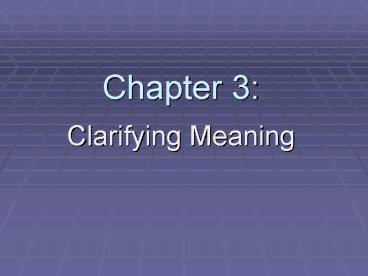Clarifying Meaning - PowerPoint PPT Presentation
1 / 22
Title:
Clarifying Meaning
Description:
He orders a sandwich, eats it, then draws a gun and proceeds to fire it at the ... 5. Essays will be returned to the student without being graded, if they are ... – PowerPoint PPT presentation
Number of Views:43
Avg rating:3.0/5.0
Title: Clarifying Meaning
1
Chapter 3
- Clarifying Meaning
2
Grammatical Ambiguity
- The use of a sentence is grammatically ambiguous
when it allows two or more possible
interpretations. - E.g., Eats shoots and leaves.
- A Panda Bear eats shoots and leaves
3
- A panda walks into a café. He orders a sandwich,
eats it, then draws a gun and proceeds to fire it
at the other patrons.Why? asks the confused,
surviving waiter amidst the carnage, as the panda
makes towards the exit. The panda produces a
badly punctuated wildlife manual and tosses it
over his shoulder.Well, Im a panda, he says
at the door. Look it up.The waiter turns to
the relevant entry in the manual and, sure
enough, finds an explanation. Panda. Large
black-and-white bear-like mammal, native to
China. Eats, shoots and leaves.
4
Examples
- Lord Denning spoke against the artificial
insemination of women in the House of Lords - Olga decided to quit smoking while driving to
Toronto. - He promised to pay Patrick and Michael 50 to
clear all of the junk out of the basement and
take it to the dump.
5
Use and Mention
- A word is mentioned if it is the word itself that
you are talking about. - E.g. Chicago has 7 letters.
- A word is used if we are talking, not about the
word, but what the word denotes. - E.g., Chicago is a city.
6
Use and Mention
- Ambiguities can arise if it is not clear whether
the word is being used or mentioned - The most useful way of disambiguating the use and
mention of a word is through the use of quotation
marks. - Put quotes around words that you are mentioning.
- Sometimes, the italicization or capitalization of
word will be used to disambiguate.
7
Self-Test No. 4
- P. 68
8
Analytic, Contradictory and Synthetic Statements
- Analytic (defn) a statement which true by
definition. - Or A statement which is true in virtue of what
the words mean. - Also Some of the statements are regarded as
analytic because of the form of those sentences.
9
Examples
- All bachelors are unmarried adult males.
- It is raining now or it is not raining now.
10
Analytic, Contradictory and Synthetic Statements
- Contradictory (defn) a statement which is false
by definition. - Or a statement which is false in virtue of what
the words mean. - Also (and more usually) false in virtue of the
form of the sentence.
11
Examples
- Some bachelors are married.
- The board is both white and not white.
12
Analytic, Contradictory and Synthetic Statements
- Synthetic (defn) a statement which neither
analytic nor contradictory - Or Its truth or falsity is not determined by the
meanings of the words. - Its truth or falsity is determined by the way the
world is.
13
Examples
- All bachelors are lonely.
- It is raining.
14
Self-Test No. 5
- p. 71
15
Necessary and Sufficient Conditions
- Conditional statements (defn) these sorts of
statements state the conditions that must be met
for some other event/action to arise. - The conditions that must be met are called the
antecedent conditions. - The outcome, once the conditions are met, is
called the consequent.
16
Necessary and Sufficient Conditions
- Examples
- You must be 19 to drink alcohol. (Being 19 is a
condition that must be met in order for you to be
permitted to drink alcohol). - Water will boil at 100C. (Being heated to 100C is
a condition that must be met in order for water
to boil)
17
Necessary and Sufficient Conditions
- There are two types of conditions found in
conditional statements - A) necessary conditions
- B) sufficient conditions
- In order to avoid misinterpretation, it is
necessary that we be able to distinguish these.
18
Necessary and Sufficient Conditions
- Necessary condition (defn) X is a necessary
condition for Y iff when X is false Y must be
false also - Sufficient condition (defn) X is a sufficient
condition for Y iff when X is true, Y must also
be true.
19
Necessary Conditions
- E.g Being 18 is a condition for being eligible
to vote - You can vote only if you are 18.
- If you are not 18 then you cannot vote
20
Sufficient Conditions
- E.g., Holding a BA from the University is a
condition for being a member of the alumni
association. - If you hold a BA then you are a member of the
association. - You are a member of the association if you hold a
BA
21
Examples
- To bring down a fever, apply a cloth dampened in
cold water to the patients face, arms and legs. - You cannot get an A average unless you work hard
throughout the whole term.
22
Examples
- 5. Essays will be returned to the student without
being graded, if they are submitted without a
proper bibliography. - 7. No one can become Prime Minister in our system
of government unless he or she is a Member of
Parliament. - 9. You have to be in good physical condition to
be a skier.































